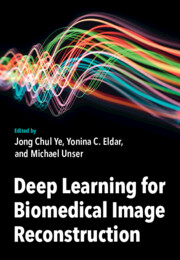Book contents
- Frontmatter
- Dedication
- Contents
- List of Contributors
- Preface
- Part I Theory of Deep Learning for Image Reconstruction
- Part II Deep-Learning Architecture for Various Imaging Architectures
- Part III Generative Models for Biomedical Imaging
- 12 Image Synthesis in Multi-Contrast MRI with Generative Adversarial Networks
- 13 Regularizing Deep-Neural-Network Paradigm for the Reconstruction of Dynamic Magnetic Resonance Images
- 14 Regularizing Neural Network for Phase Unwrapping
14 - Regularizing Neural Network for Phase Unwrapping
from Part III - Generative Models for Biomedical Imaging
Published online by Cambridge University Press: 15 September 2023
- Frontmatter
- Dedication
- Contents
- List of Contributors
- Preface
- Part I Theory of Deep Learning for Image Reconstruction
- Part II Deep-Learning Architecture for Various Imaging Architectures
- Part III Generative Models for Biomedical Imaging
- 12 Image Synthesis in Multi-Contrast MRI with Generative Adversarial Networks
- 13 Regularizing Deep-Neural-Network Paradigm for the Reconstruction of Dynamic Magnetic Resonance Images
- 14 Regularizing Neural Network for Phase Unwrapping
Summary
Quantitative phase imaging (QPI) refers to label-free techniques that produce images containing morphological information. In this chapter, we focus on 2D phase imaging with a holographic setup. In such a setting, the complex-valued measurements contain both intensity and phase information. The phase is related to the distribution of the refractive index of the underlying specimen. In practice, the collected phase happens to be wrapped (i.e., modulo 2π of the original phase) and one gains quantitative information on the sample only once the measurements are unwrapped. The process of phase unwrapping relies on the solution of an inverse problem, for which numerous methods exist. However, it is challenging to unwrap the phases of particularly complex or thick specimens such as organoids. Under such extreme conditions, classical methods often exhibit unwrapping errors. In this chapter we first formulate the problem of phase unwrapping and review the existing methods to solve it. Then, we present an application of a regularizing neural network to phase unwrapping, which allows us to outline the advantages of a training-free approach, i.e., a deep image prior, over classical methods or supervised learning.
- Type
- Chapter
- Information
- Deep Learning for Biomedical Image Reconstruction , pp. 312 - 324Publisher: Cambridge University PressPrint publication year: 2023



